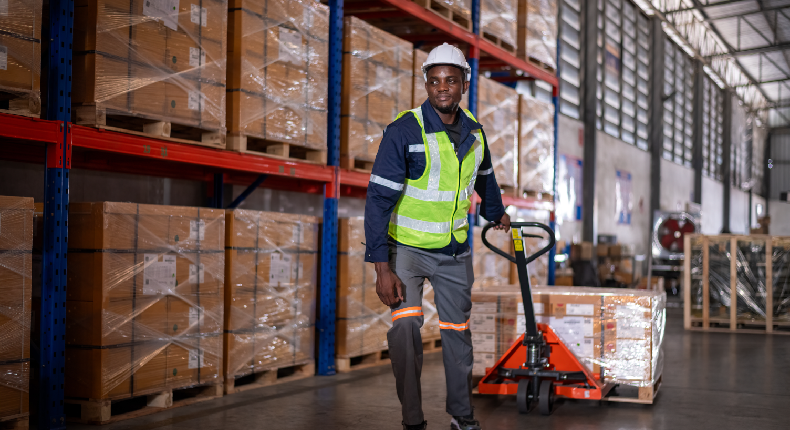Information
Legal information
Funded by


Palletisation is a fundamental process in modern logistics and warehouse management. It allows for the efficient grouping and handling of products through the use of pallets. Below, everything you need to know about this procedure is detailed, from its definition to its advantages and types.
Índice de contenidos
TogglePalletisation is the technique by which goods are grouped onto a structure called a pallet to facilitate their handling, storage, and transport. This process optimises space, protects products, and improves efficiency in load handling.
Palletisation has a series of characteristics that make it a decisive practice for efficiency and safety in handling goods, making it an indispensable technique in industries.
The palletisation process can vary depending on the type of products and the specific needs of each company, but the following steps are necessary to perform palletisation correctly:
The choice of the correct pallet depends on the type of product, its weight and dimensions, and the requirements for transport and storage. It is essential to select a pallet that adequately supports the load and adapts to logistical conditions, thus guaranteeing the integrity of the products throughout the process.
Products are grouped in an orderly and stable manner on the pallet. This stage can be done manually or through automated systems, ensuring that the products are well distributed to maximise space use and minimise the risks of displacement or damage during transport.
Once grouped, the products are secured to the pallet using methods such as strapping, wrapping, or netting to ensure they stay in place during transport. The choice of securing method depends on the type of products and their specific protection and stability needs.
Loaded pallets are stored on specific racks or transported using equipment such as forklifts, cranes, or conveyor systems. This equipment facilitates the efficient and safe movement of pallets, ensuring that products reach their destination in perfect condition and optimising workflow in the warehouse.
There are several palletisation methods, each adapted to different needs and types of products:
This method involves placing products on pallets by workers without the aid of automated machinery. It is suitable for smaller-scale operations or where automation is not feasible. Key features of manual palletisation include:
However, manual palletisation also has disadvantages, such as lower efficiency and a higher possibility of human error. Additionally, it can be physically demanding for workers, affecting productivity and occupational safety.
Semi-automatic palletisation combines manual labour with machinery that facilitates the grouping and securing of products. This method offers a balance between the flexibility of manual palletisation and the efficiency of automatic. Main characteristics include:
Equipment used in semi-automatic palletisation includes pallet wrappers, conveyor belts, and stretch film dispensers. These machines improve load stability and security, ensuring that products remain in place during transport.
Automatic palletisation uses robotic systems and automated production lines to perform the entire process. It is ideal for large volumes and continuous operations, enhancing speed and precision. Key features of this method are:
Automatic palletisation systems can include palletising robots, machine vision systems for product inspection, and automated conveyor lines. These systems are highly configurable and can integrate with other production and logistics processes to optimise workflow.
The use of palletisation offers multiple benefits to logistics and warehousing operations, improving efficiency and safety throughout the supply chain.
Palletisation optimises the time and resources needed for handling products, allowing for faster loading and unloading processes. By standardising the grouping of products on pallets, the use of automated equipment such as forklifts and transport systems is facilitated, speeding up operations and reducing waiting times.
It minimises costs associated with storage and transport, as it allows better space utilisation and reduces handling time. By improving product organisation and maximising available space use, storage costs are decreased. Additionally, handling efficiency reduces the need for labour, contributing to lower operational expenses.
It decreases the risk of product damage and workplace accidents by ensuring safer and more stable load handling. The stability provided by well-configured pallets reduces the likelihood of products falling or being damaged during transport. Moreover, workers face fewer physical risks when handling palletised loads, promoting a safer working environment.
It offers the ability to adapt to different types of products and needs, thanks to the variety of pallets and securing methods available. The capability to customise pallet configurations allows companies to handle a wide range of products, from small and light items to large and heavy ones. This flexibility is crucial for responding to changing market demands and specific customer needs.
It promotes more sustainable practices by enabling the reuse of pallets and reducing the use of disposable packaging materials. By opting for reusable pallets and eco-friendly securing systems, companies can reduce their environmental footprint. Reducing waste and efficient resource use also contribute to long-term sustainability, aligning with the growing demands for environmental responsibility in the logistics sector.
Palletisation has become an important pillar for efficient supply chain and logistics management. This process not only facilitates the handling and transport of products but also offers multiple operational, economic, and safety advantages. By understanding and properly applying the different palletisation methods, companies can optimise their operations and remain competitive in an increasingly demanding market.
Information
Legal information
Funded by


